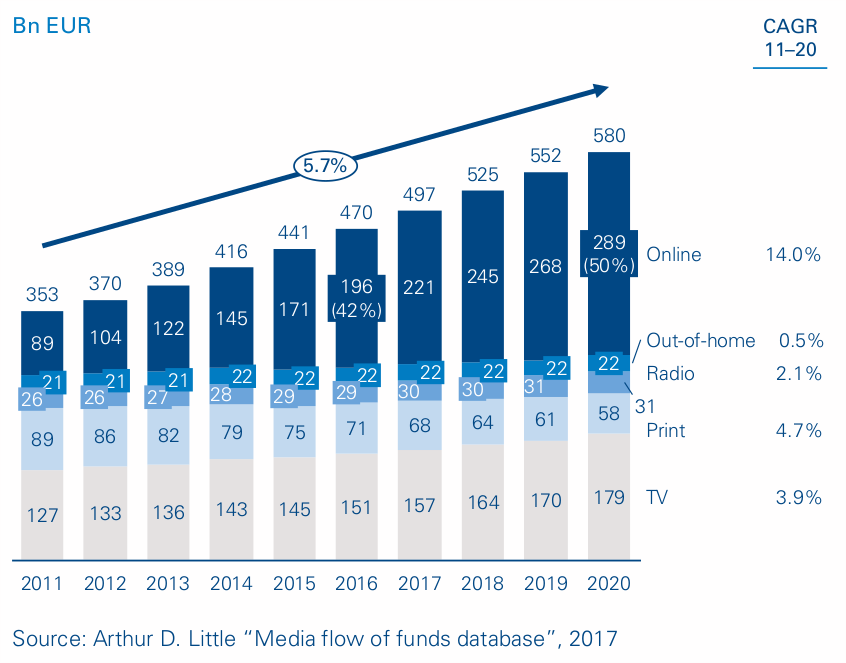
At the dawn of internet, content publishers started generating revenues by advertising products and services of the real world on their websites. Today the advertising industry is a blend of digital and physical media, and companies need to stay on top of its fast evolution. Following the original path, but years later, marketing and sales practices are relying more and more on digital channels. However, companies do not take most of the potential opportunities, because they are still tied to conventional customer engagement models and operate through traditional organizational structures.
Digital advertising investments are growing at a fast pace, with over 17 percent CAGR since 2011 and reaching 42 percent of total global ad spending. The forecasts see this shift continuing up to 50 percent in 2020, and in some markets, the share will be even larger. Here the key issue seems to be how to optimize ad spending, balancing the media mix between online and offline and earned and paid media, in order to maximize advertising effectiveness. In this regard, new trends are coming up, showing increasing integration between physical and digital channels: audience targeting, mobile and apps, social media, hot spots and IoT devices must be properly leveraged to unleash the full potential of future advertising campaigns.
As sales and advertising evolve online, customers are also increasingly using digital channels to shop, compare, interact and communicate, generating a huge amount of information about their needs and expectations. The potential behind this data is driving investments in big data software and tools, which globally accounted for over $22 bn in 2015 and is expected to grow at a 47 percent CAGR in the next four years. However, investing in sophisticated technologies does not create value if marketing fails to create a comprehensive model to turn data into sales opportunities. Nowadays, companies are struggling to deal with a more and more sophisticated customer. Online and offline touch points are generally unbound, failing to create the unique and continuous journey customers expect. The main challenge for digital marketing is to rule the omnichannel customer experience by embracing a vision to integrate marketing and sales processes aimed at increasing lead generation and conversion. Therefore, a new engagement model is key to interacting with the customer on the journey, which takes place in both the digital and physical worlds. According to a 2017 survey of US senior executives about big data business impact, 85 percent of respondents said their companies had started programs to create data-driven cultures, but only 37 percent reported success so far. The issues are associated with management understanding, organizational alignment and organizational resistance.
Marketers are facing the above-mentioned challenges, which demand a redesign of processes, tools and competencies to cope with the new paradigm of the digital era. We envision the marketing department of the future as a function that generates fast and continuous data-driven market insight, directly governs and influences the sales channels and integrates its operations with the sales department to guarantee a seamless experience for the potential customer.
1. The evolution from paid to earned media
In 2016, the global advertising spend amounted to EUR 470 bn, with TV advertising and online advertising as the two largest segments. However, online advertising has rapidly grown in importance over the past 10 years, and by 2020, it will represent more than half of total advertising spend. In some leading countries, online advertising was already by far the largest advertising segment in 2016 (e.g., UK 58 percent of total ad spend, France 49 percent, Germany 43 percent, South Korea 42 percent).
Figure 1: Global advertising spend by type, 2011–2020

The range of online advertising types is rapidly expanding, and so far more than 20 sub-segments exist. For simplicity, they can be clustered into four main segments: online classifieds, video, paid search and display advertising. All main segments show strong growth until 2020, although classifieds and display advertising will prove somewhat less dynamic in comparison to video and search advertising.
The main advantages of online advertising over other media is the opportunity to efficiently address specific groups of customers. In order to serve targeted advertising, a number of elements need to be in place:
- The ability to identify a given recipient of an advertisement
- The knowledge of relevant targeting information for that individual
- The ability to distribute the targeted advertisement




